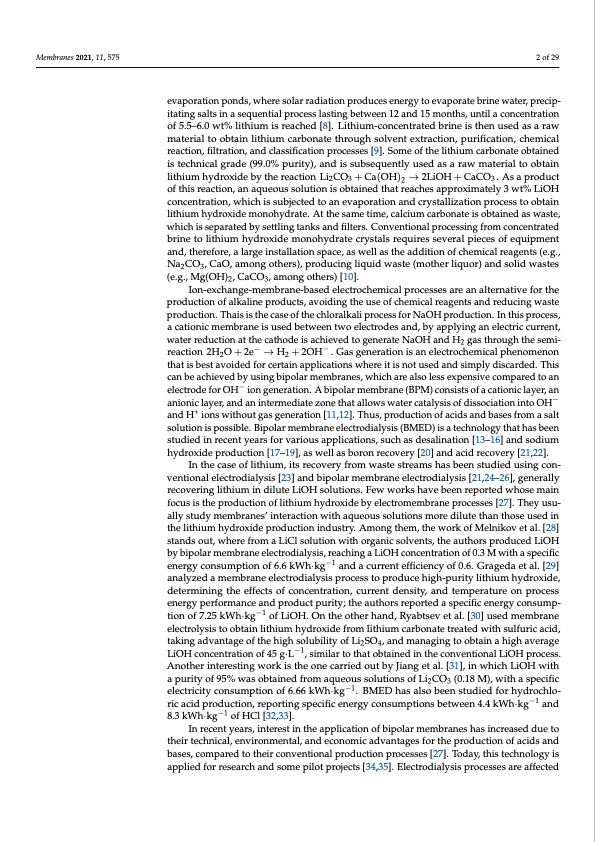
PDF Publication Title:
Text from PDF Page: 002
Membranes 2021, 11, 575 2 of 29 evaporation ponds, where solar radiation produces energy to evaporate brine water, precip- itating salts in a sequential process lasting between 12 and 15 months, until a concentration of 5.5–6.0 wt% lithium is reached [8]. Lithium-concentrated brine is then used as a raw material to obtain lithium carbonate through solvent extraction, purification, chemical reaction, filtration, and classification processes [9]. Some of the lithium carbonate obtained is technical grade (99.0% purity), and is subsequently used as a raw material to obtain lithium hydroxide by the reaction Li2CO3 + Ca(OH)2 → 2LiOH + CaCO3 . As a product of this reaction, an aqueous solution is obtained that reaches approximately 3 wt% LiOH concentration, which is subjected to an evaporation and crystallization process to obtain lithium hydroxide monohydrate. At the same time, calcium carbonate is obtained as waste, which is separated by settling tanks and filters. Conventional processing from concentrated brine to lithium hydroxide monohydrate crystals requires several pieces of equipment and, therefore, a large installation space, as well as the addition of chemical reagents (e.g., Na2CO3, CaO, among others), producing liquid waste (mother liquor) and solid wastes (e.g., Mg(OH)2, CaCO3, among others) [10]. Ion-exchange-membrane-based electrochemical processes are an alternative for the production of alkaline products, avoiding the use of chemical reagents and reducing waste production. Thais is the case of the chloralkali process for NaOH production. In this process, a cationic membrane is used between two electrodes and, by applying an electric current, water reduction at the cathode is achieved to generate NaOH and H2 gas through the semi- reaction 2H2O + 2e− → H2 + 2OH− . Gas generation is an electrochemical phenomenon that is best avoided for certain applications where it is not used and simply discarded. This can be achieved by using bipolar membranes, which are also less expensive compared to an electrode for OH− ion generation. A bipolar membrane (BPM) consists of a cationic layer, an anionic layer, and an intermediate zone that allows water catalysis of dissociation into OH− and H+ ions without gas generation [11,12]. Thus, production of acids and bases from a salt solution is possible. Bipolar membrane electrodialysis (BMED) is a technology that has been studied in recent years for various applications, such as desalination [13–16] and sodium hydroxide production [17–19], as well as boron recovery [20] and acid recovery [21,22]. In the case of lithium, its recovery from waste streams has been studied using con- ventional electrodialysis [23] and bipolar membrane electrodialysis [21,24–26], generally recovering lithium in dilute LiOH solutions. Few works have been reported whose main focus is the production of lithium hydroxide by electromembrane processes [27]. They usu- ally study membranes’ interaction with aqueous solutions more dilute than those used in the lithium hydroxide production industry. Among them, the work of Melnikov et al. [28] stands out, where from a LiCl solution with organic solvents, the authors produced LiOH by bipolar membrane electrodialysis, reaching a LiOH concentration of 0.3 M with a specific energy consumption of 6.6 kWh·kg−1 and a current efficiency of 0.6. Grageda et al. [29] analyzed a membrane electrodialysis process to produce high-purity lithium hydroxide, determining the effects of concentration, current density, and temperature on process energy performance and product purity; the authors reported a specific energy consump- tion of 7.25 kWh·kg−1 of LiOH. On the other hand, Ryabtsev et al. [30] used membrane electrolysis to obtain lithium hydroxide from lithium carbonate treated with sulfuric acid, taking advantage of the high solubility of Li2SO4, and managing to obtain a high average LiOH concentration of 45 g·L−1, similar to that obtained in the conventional LiOH process. Another interesting work is the one carried out by Jiang et al. [31], in which LiOH with a purity of 95% was obtained from aqueous solutions of Li2CO3 (0.18 M), with a specific electricity consumption of 6.66 kWh·kg−1. BMED has also been studied for hydrochlo- ric acid production, reporting specific energy consumptions between 4.4 kWh·kg−1 and 8.3 kWh·kg−1 of HCl [32,33]. In recent years, interest in the application of bipolar membranes has increased due to their technical, environmental, and economic advantages for the production of acids and bases, compared to their conventional production processes [27]. Today, this technology is applied for research and some pilot projects [34,35]. Electrodialysis processes are affectedPDF Image | Bipolar Membrane Electrodialysis for LiOH Production

PDF Search Title:
Bipolar Membrane Electrodialysis for LiOH ProductionOriginal File Name Searched:
membranes-11-00575-v2.pdfDIY PDF Search: Google It | Yahoo | Bing
Product and Development Focus for Infinity Turbine
ORC Waste Heat Turbine and ORC System Build Plans: All turbine plans are $10,000 each. This allows you to build a system and then consider licensing for production after you have completed and tested a unit.Redox Flow Battery Technology: With the advent of the new USA tax credits for producing and selling batteries ($35/kW) we are focussing on a simple flow battery using shipping containers as the modular electrolyte storage units with tax credits up to $140,000 per system. Our main focus is on the salt battery. This battery can be used for both thermal and electrical storage applications. We call it the Cogeneration Battery or Cogen Battery. One project is converting salt (brine) based water conditioners to simultaneously produce power. In addition, there are many opportunities to extract Lithium from brine (salt lakes, groundwater, and producer water).Salt water or brine are huge sources for lithium. Most of the worlds lithium is acquired from a brine source. It's even in seawater in a low concentration. Brine is also a byproduct of huge powerplants, which can now use that as an electrolyte and a huge flow battery (which allows storage at the source).We welcome any business and equipment inquiries, as well as licensing our turbines for manufacturing.| CONTACT TEL: 608-238-6001 Email: greg@infinityturbine.com | RSS | AMP |